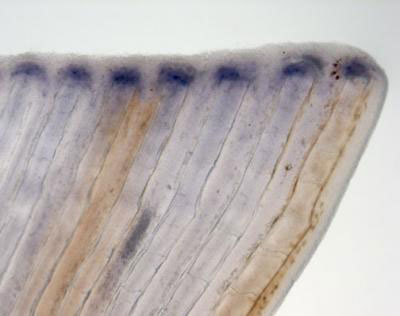| Mar 27, 2014 |
To grow or not to grow: a step forward in adult vertebrate tissue regeneration
|
|
(Nanowerk News) The reason why some animals can regenerate tissues after severe organ loss or amputation while others, such as humans, cannot renew some structures has always intrigued scientists. In a study now published in PLOS ONE ("V-ATPase Proton Pumping Activity Is Required for Adult Zebrafish Appendage Regeneration"), a research group from Instituto Gulbenkian de Ciência (IGC, Portugal) led by Joaquín Rodríguez León provided new clues to solve this central question by investigating regeneration in an adult vertebrate model: the zebrafish.
|
 |
| The regeneration of the zebrafish's fin requires V-ATPase enzyme (area marked in blue).
|
|
It was known that zebrafish is able to regenerate organs, and that electrical currents may play a role in this process, but the exact mechanisms are still unclear. Using both biophysical and molecular approaches, the researchers have shown, for the first time, that zebrafish regenerates its caudal fin by a process that involves a specific channel in the cell membrane, called V-ATPase, that pumps hydrogen ions (H+) out of the cells generating an electrical current. Understanding these mechanisms underlying adult tissue regeneration may be instrumental for the development of new therapeutic strategies, both in regenerative and developmental medicine.
|
|
Cell regeneration is a biological feature of all living organisms with an important role in growth, wound healing, tissue repair and similar biological functions. Scientists have been investigating the molecular aspects that underline regeneration aiming to understand why some animals have the ability to regrow entire tissue structures after amputation or injury whereas humans can just regenerate few organs, such as the liver or the skin.
|
|
The classical approach has been to look at genes and proteins, and only more recently, the relevance of bioelectric signals began to be investigated.
|
|
Researchers from Joaquín Rodríguez León's laboratory set out to analyze the contribution of different ion fluxes in the cell membrane, either inwards or outwards, during regeneration in the zebrafish caudal fin. They discovered that only the transport of hydrogen ions or protons (H+) played a role in the regenerative process. The research team observed that this transport occurred via V-ATPase enzyme, that forms a channel in the cell membrane and pumps H+ out of the cell.
|
|
The researchers discovered that the activity of this electric signal is necessary in different aspects of normal regeneration, namely for the expression of crucial genes, formation of a mass of cells capable of growth and regenerate, and proper tissue innervation. The researchers found that this electric current was also important to coordinate other proteins that could establish a positional memory to ensure the correct regeneration of the injured tissue.
|
|
Joaquín Rodríguez-León says: "Scientists use different strategies to unveil the mechanisms behind regeneration to apply this knowledge in the future clinical practice. Some teams are studying the potential of stem cells and others try to understand why some animals can regenerate. Our team contributes to understand how the cellular machinery, that is similar in all vertebrates, can regenerate a structure in an animal. Particular cellular machinery needs to be "switched on" and that is what we try to understand. Using the zebrafish as a model, we have found that an essential feature of cells, ion dynamics, contributes to the regeneration of limbs. Specifically, we have found that H+ (protons) actively contribute to create an electric current that is needed for proper regeneration."
|

